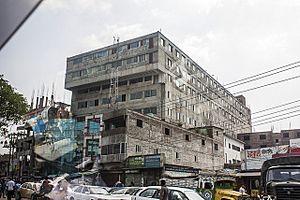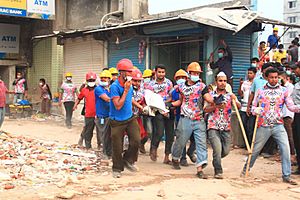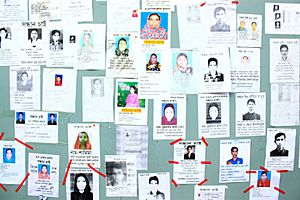Rana Plaza collapse facts for kids
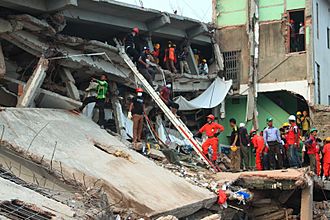
Side view of the collapsed building
|
|
| Date | 24 April 2013 (10 years ago) |
|---|---|
| Time | 08:45 am BST (UTC+06:00) |
| Location | Savar Upazila, Dhaka District, Bangladesh |
| Coordinates | 23°50′46″N 90°15′27″E / 23.84611°N 90.25750°E |
| Also known as | Savar building collapse |
| Deaths | 1,134 |
| Non-fatal injuries | ~2,500 |
| Suspects | Sohel Rana |
| Charges | Murder |
The Rana Plaza collapse was a terrible accident that happened on April 24, 2013, in Savar Upazila, Dhaka District, Bangladesh. An eight-story building called Rana Plaza suddenly fell down. This disaster led to the deaths of 1,134 people, and about 2,500 others were hurt. It is known as the deadliest building collapse in modern history and the worst accident ever in a clothing factory.
The building had many clothing factories, a bank, and several shops. Cracks were seen in the building the day before it collapsed. The shops and bank closed right away. However, the building's owners told the factory workers to come back to work the next day, even though it was dangerous. The building then collapsed during the busy morning hours.
Contents
What Was Rana Plaza?
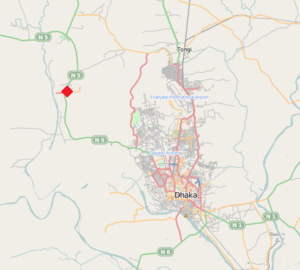
Rana Plaza was built in 2006 and belonged to Sohel Rana, a local businessman. It was a large building that housed many different clothing factories. Around 5,000 people worked there, making clothes for big brands like Benetton, Zara, The Children's Place, and Walmart. There were also shops and a bank in the building.
The top four floors of Rana Plaza were built without proper permission. The building's original design was for shops and offices, not for heavy factories. Experts warned that factories, with their heavy machines and vibrations, needed a much stronger building structure.
On April 23, 2013, just one day before the collapse, TV news showed pictures of cracks in the building. People quickly left the building, and the shops and bank closed. But later that day, Sohel Rana told the media that the building was safe. Managers at one factory even threatened to not pay workers if they didn't come back to work.
The Collapse and Rescue Efforts
On the morning of April 24, 2013, the power went out. Diesel generators on the top floor were started to keep the factories running. At about 8:57 AM, the building suddenly fell down, leaving only the ground floor standing. About 3,122 workers were inside at that time. People nearby said it felt like an earthquake.
The United Nations offered to send expert rescue teams to help, but the government of Bangladesh said no. They stated that their own rescue services could handle it. Many volunteers helped with the rescue, but they often lacked proper equipment and safety gear. Some trapped workers had to find ways to survive the heat while waiting to be saved.
Many of the people who died were women, and some of their children were also in day care centers inside the building. Police, fire services, and military personnel all helped with the rescue. A national day of mourning was held on April 25.
Seventeen days after the collapse, on May 10, a woman named Reshma was found alive and mostly unharmed under the rubble. This was a hopeful moment during a very sad time.
Why Did Rana Plaza Collapse?
Several problems led to the collapse of Rana Plaza:
- The building was built on land that used to be a pond. This made the ground weak and affected the building's strength.
- The building was changed from being used for shops to being used for heavy factories. It was not designed to handle the weight and vibrations of factory machines.
- Four extra floors were added to the building without permission. These floors were not part of the original plan.
- Poor quality building materials were used. This made the structure even weaker, especially with the added weight and vibrations from the generators and heavy machines.
These issues show that there were bad business practices by the owner, Sohel Rana, and problems with how building rules were enforced in Savar.
Before the collapse, an engineer named Abdur Razak Khan said the building was unsafe. He asked officials to check it more carefully. However, another official, Kabir Hossain Sardar, visited the site and said the building was safe after meeting with Sohel Rana. Sohel Rana then told the media and factory managers that workers should return. Because of this, and threats of not being paid, workers went back to the dangerous building.
Safety and Business Practices
Factory managers sent workers back to the building partly because they needed to finish clothing orders on time. This puts some responsibility on the "fast fashion" industry, which demands quick and cheap production. Some people argue that the need for low-cost clothing meant that big brands didn't check the factories closely enough.
After another factory collapse in 2005, some manufacturers started programs to improve safety. However, these programs failed to prevent the Rana Plaza disaster. Even though safety checks were done at some factories in Rana Plaza, they did not find the serious problems with the building's structure. This shows that the checks were not good enough.
Investigations are still ongoing to find out all the causes and who is responsible.
What Happened After the Collapse?
The day after the collapse, legal action was started against the building owners and the factory owners. The Prime Minister of Bangladesh ordered the arrest of Sohel Rana. He was later caught near the border.
Workers and their families protested in the streets, demanding safer working conditions and justice. They wanted the owner of Rana Plaza to be punished. On May 1, which is International Workers' Day, thousands of people marched in Dhaka to ask for better safety and fair pay.
Many factories were closed down as part of new safety rules. Officials promised to pay the workers their missed wages and provide help. However, some victims' families had trouble getting compensation because they lacked official documents.
Global Reactions
The Rana Plaza collapse caused a lot of discussion around the world about how companies should be responsible for their supply chains. Many politicians and leaders spoke out.
Pope Francis called the working conditions "slave labor" and said it was wrong to only care about profits. Human Rights Watch and other groups pointed out that there had been many factory accidents in Bangladesh.
Workers' rights groups like IndustriALL Global Union started campaigns to demand better labor laws and safer conditions in Bangladesh. Protests were held outside stores of brands like Primark and Benetton, which had clothes made in Rana Plaza. These groups demanded that the brands contribute to a fund to help the victims.
Many people around the world also expressed anger at retailers that sourced clothes from unsafe factories in Bangladesh.
Help for Victims
For months after the disaster, discussions continued about how to pay compensation to the victims' families. Many families struggled because they had lost the person who earned money for them. Some families found it hard to get compensation because they needed DNA evidence to prove their relative had died.
Of the many brands that had clothes made in Rana Plaza, only a few agreed to contribute to a special compensation fund. Brands like Primark and Loblaw signed the agreement, but others like Walmart and Carrefour did not. By March 2014, only seven out of 28 international brands had contributed to the fund, which was supported by the International Labour Organization.
Legal Cases
In 2014, legal cases were started against 14 people for building Rana Plaza with a faulty design. In 2015, murder charges were filed against 42 people, including the building's owner, Sohel Rana. If found guilty of murder, they could face the death penalty.
In 2017, Sohel Rana was sentenced to three years in prison for not telling the government about his personal wealth. As of 2021, the murder trial and the building code violation trial are still ongoing. Only Sohel Rana remains in jail, while others accused are out on bail, have run away, or have died.
Global Impact
The Rana Plaza collapse made people think more about how companies manage their global supply chains. Experts suggested that companies need to check their suppliers more carefully, not just the main ones they work with directly. They also said that working with local partners and universities is important for managing social responsibility.
On April 24, 2014, one year after the disaster, thousands of people gathered near the collapse site to remember the victims.
|
See also
 In Spanish: Colapso de un edificio en Savar en 2013 para niños
In Spanish: Colapso de un edificio en Savar en 2013 para niños
- Exploitation of labour
- Sweatshop
- List of disasters in Bangladesh by death toll
- Other garment factory disasters:
- Triangle Shirtwaist Factory fire (1911)
- Pakistan garment factory fires (2012)
- Other building collapses:
- Pemberton Mill (1860 collapse)
- Collapse of Hotel New World (1986)
- Sampoong Department Store collapse (1995)
- Collapse of the World Trade Center (2001)
- Thane building collapse (2013)
- Riga supermarket roof collapse (2013)
- Surfside condominium building collapse (2021)
- Organizations
- Alliance for Bangladesh Worker Safety


